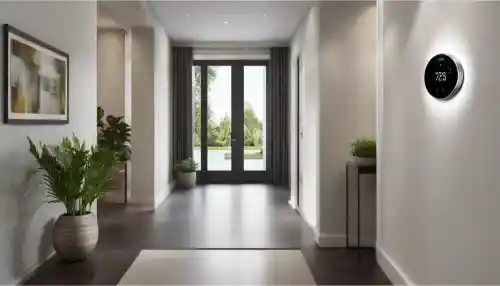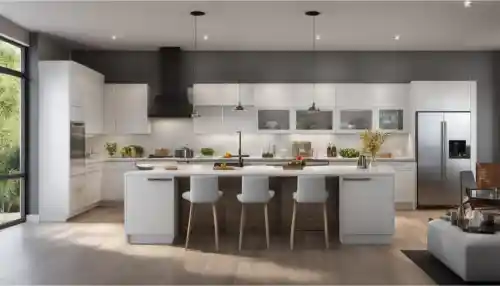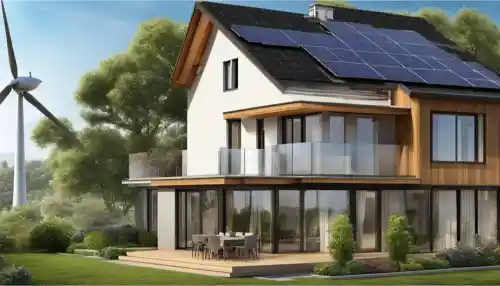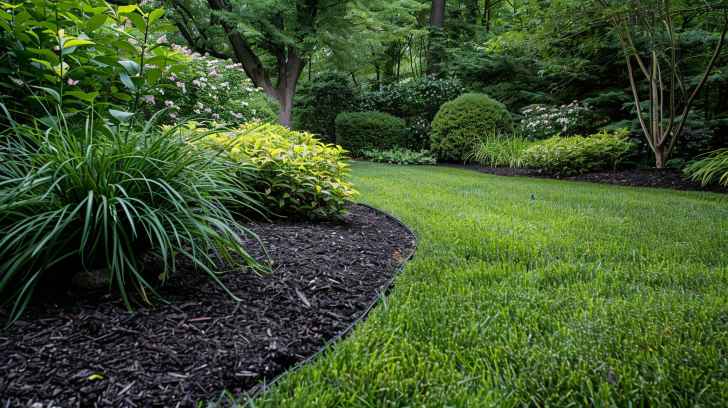If you’re feeling the pinch from high utility bills, you’re certainly not alone. Homeowners throughout the United States are constantly seeking effective methods to lower electricity bills and enhance their energy-saving habits. The good news is that there are several proven strategies that can help you save home energy and achieve home energy cost reduction. By making a few smart tweaks around the house, you can contribute to reducing energy waste and embrace more eco-friendly energy choices.
Tapping into these ingenious approaches doesn’t just benefit your wallet; it’s also a step towards a more sustainable lifestyle. In the sections to come, we’ll explore the most impactful changes you can implement to significantly decrease your energy expenditures and add that much-needed breathing room to your monthly budget.
Key Takeaways
- Discover innovative ways to significantly save home energy and lower your bills.
- Learn to establish energy-saving habits that can lead to long-term financial and environmental benefits.
- Understand how simple changes in your home can contribute to lower electricity bills.
- Gain insight into how reducing energy waste isn’t just good for your pocket, but the planet too.
- Find out why opting for eco-friendly energy choices is a smart move for the conscientious homeowner.
Embrace Smart Thermostat Technology
With the advent of smart thermostats, managing your home’s temperature has never only been about comfort, but also about home energy efficiency. These innovative devices bring forward a future where energy-efficient home upgrades are not just a trend, but a standard practice, significantly contributing to a green home solutions. Let’s explore the financial savviness these gadgets offer and the incentives available to make them an integral part of your household.
How Programmable Thermostats Save Money
Programmable thermostats grant you the control you need to optimize your home’s heating and cooling without exhaustive effort. By setting automated schedules, you can enable the system to reduce energy consumption when you’re not at home, or during the hours you’re asleep. These programmable thermostats can lead to savings of up to 15% on your heating costs annually.
By simply setting and forgetting your thermostat, you’re paving the way for significant cost reductions in your energy bills all year round.
Optimizing Thermostat Settings for Seasonal Savings
Whether it’s the sweltering summer heat or the chilly winter breeze, knowing the right settings for your thermostat can make all the difference. Hint: the key lies in adjusting the temperature for the times you’re least active or out for the day. Here’s a mini-guide to help you tweak those settings seasonally:
| Season | Daytime Setting (When Home) | Nighttime / Away Setting |
|---|---|---|
| Winter | 68°F | 60-65°F |
| Summer | 78°F | 82°F or Off |
Smart Thermostat Rebates and Incentives
Adopting smart thermostats can be more wallet-friendly than you think, thanks to various rebates and incentives offered by manufacturers, utility companies, and government programs. These incentives are designed to ease the transition towards high-efficiency appliances, making them an excellent choice for those seeking home energy rebates.
- Check with your local utility company for available rebates on energy-efficient appliances.
- Look into whether you qualify for any government tax credits when installing smart home technology.
- Manufacturers occasionally offer discounts on smart thermostats to promote sustainable living.
Utilizing these rebates not only lowers the initial investment but also accelerates the time it takes to recoup costs through energy savings.

Remember, making the switch to smart and programmable thermostats goes beyond personal benefits. It is a positive step towards a sustainable future, embodying the essence of green home solutions and fostering good stewardship of our natural resources.
Master Home Insulation Tactics
If your goal is to reduce heating costs and create an energy-saving oasis within your home, focusing on home insulation is crucial. Adequate insulation not only helps weatherproofing homes but is also a linchpin in the design of energy-efficient home designs. Begin by understanding the essential types of insulation materials available to make informed decisions.

Choosing the Right Insulation Materials
When it comes to energy-saving home insulation, selecting the right materials makes all the difference. Cellulose, fiberglass, and spray foam each have unique benefits that cater to different insulation needs and can play a significant role in improving your home’s energy efficiency.
DIY Insulation Tips for Attics and Basements
Many times, the attic and basement are the main sources of energy loss in a home. You can undertake a DIY insulation project to seal these critical areas effectively. Simple steps such as adding additional layers or ensuring even distribution can help you achieve professional results.
Sealing Air Leaks to Enhance Efficiency
Moreover, the companion to good insulation is sealing air leaks. It is an indomitable factor in the bid to reduce heating costs and boost your home’s overall energy efficiency. Utilizing techniques such as weatherstripping and caulking can address those sneaky gaps around your windows and doors.
| Insulation Material | Benefits | Best Use |
|---|---|---|
| Cellulose | Environmentally friendly, effective sound barrier | Attics, wall cavities |
| Fiberglass | Cost-effective, non-flammable | Basements, unfinished walls |
| Foam | High R-value per inch, reduces air infiltration | Enclosed existing walls, unfinished attic floors |
Leverage Energy-Efficient Appliances
Expanding your home’s energy efficiency can be as straightforward as upgrading to energy-efficient appliances. Today’s market boasts a vast array of Energy Star appliances that have undergone rigorous testing to ensure they meet the highest standards for energy savings. Picture a sleek new refrigerator or a whisper-quiet dishwasher, both cutting your utility bills and conserving natural resources.

An important step in enhancing home energy efficiency is understanding the types of appliances that make the most impact. Consider how energy-efficient cooling systems not only reduce your environmental footprint but also keep your home comfortable during those sweltering summer months. Moreover, spotlighting energy-efficient HVAC systems can significantly reduce your long-term costs and offer year-round climate control.
Implementation of home energy upgrades doesn’t have to be overwhelming. Below is an insightful comparison of standard and Energy Star certified appliances to guide your investment into a greener lifestyle:
| Appliance | Annual Energy Usage (Standard) | Annual Energy Usage (Energy Star) | Annual Cost Savings |
|---|---|---|---|
| Refrigerator | 650 kWh | 450 kWh | ≈ $25 |
| Washing Machine | 500 kWh | 150 kWh | ≈ $45 |
| Dishwasher | 300 kWh | 270 kWh | ≈ $10 |
| HVAC System | 2000 kWh | 1500 kWh | ≈ $65 |
Remember, smart use of your appliances can further maximize efficiency. For instance, setting your water heater to a lower temperature or ensuring your refrigerator isn’t placed near a heat source can yield additional energy savings. And don’t forget, these energy-efficient upgrades can often be coupled with tax incentives, rebates, and savings plans offered by both manufacturers and government programs, making your shift to a sustainable household an economically savvy move.
Embrace a sustainable lifestyle by integrating energy-efficient appliances into your home and reap the benefits of reduced energy consumption and a lighter ecological footprint.
- Investigate tax incentives related to energy upgrades.
- Consider energy consumption when purchasing new appliances.
- Look for the Energy Star label for guaranteed efficiency.
Utilize Energy-Saving Lighting Solutions
As energy costs continue to rise and environmental awareness grows, making the switch to energy-saving lighting is not just a bright idea; it’s essential. The beauty of modern technology gives you powerful ways to enhance your home lighting while reducing your carbon footprint.

Benefits of Switching to LED Lighting
Long celebrated for their longevity and efficiency, LED lighting options stand out as the cornerstone of energy-efficient home lighting. By adopting this brilliant technology, you’ll notice immediate perks:
- Significantly lower energy consumption compared to incandescent and halogen light bulbs.
- A drastic reduction in heat emission, reducing the need for air conditioning.
- Exceptional lifespan, meaning fewer replacements and less waste.
Strategies for Efficient Home Lighting
Incorporate energy-saving habits in your lifestyle with these strategic moves:
- Install occupancy sensors to ensure lights are on only when needed.
- Use dimmer switches to adjust the light level, saving energy while creating ambiance.
- Choose to invest in luminary with higher lumens per watt ratio for high-traffic areas.
Maximizing Daylight and Reducing Electricity Use
Energy-saving window treatments work twofold: they enhance natural lighting during the day, while providing additional insulation, keeping your home comfortably lit and energetically balanced. Explore different options, such as reflective blinds or honeycomb shades, to bolster your home’s energy conservation.
Let’s summarize the direct impact of smart lighting choices on your energy consumption:
| Lighting Choice | Energy Savings | Longevity |
|---|---|---|
| LED Bulbs | Up to 80% | 25 times longer |
| Natural Lighting | Reduces use during daylight | N/A |
| Sensors and Dimmers | Varies with usage | Extends bulb life |
Begin monitoring and optimizing your home energy use with smart tech devices. Integrating home energy monitoring tools provides real-time insights so you can adjust your consumption accordingly, fostering a greener and more proactively managed household.
Adopting these strategies not only decreases your energy costs but also positions you as an active participant in reducing carbon emissions. Indeed, turning off a single bulb might seem trivial, yet it’s the collective flick of switches that holds the power to illuminate a path towards a more sustainable future.
Invest in Sustainable Energy Systems
More and more homeowners are turning their attention to solar power for homes, a trend driven by the desire for both an eco-conscious lifestyle and a reduction in energy expenses. Installation of home solar panels represents a significant leap towards sustainable home energy and paves the way for a plethora of benefits that go beyond mere cost savings. When you choose to employ this green technology, you’re not just cutting down on utility bills; you’re stepping into the future of energy independence.
Initially, the outlay for solar panels may seem substantial, but the longevity and energy-efficient home systems they offer provide financial benefits that accrue over time. Modern advancements in smart home energy management systems further streamline the process, allowing for an automated, finely-tuned control over your household’s energy consumption. This sophisticated integration optimizes your power usage, ensuring that your investment in solar smoothly translates to both monetary savings and environmental stewardship.
Moreover, incorporating these eco-friendly home improvements not only aids the planet by tapping into a clean, renewable energy source, but it also potentially elevates the market value of your property. It’s a transformative home upgrade that resonates with the increasing demand for sustainable living solutions among prospective homebuyers. Furthermore, to ease the transition, federal and state governments offer various incentives and rebates aimed at making solar more accessible to the average homeowner.
In today’s energy landscape, sustainability is the watchword, and investing in solar power systems for your home is a solid step towards an environmentally responsible and economically sound future. Embrace the change, reduce your carbon footprint, and fortify your home’s energy infrastructure for the years ahead.
Upgrade to Energy-Efficient Windows
Revamping your home with energy-efficient windows has been proven to be a game-changer in reducing your home energy consumption and bolstering your home heating efficiency. Not only do these windows offer a more comfortable living space by maintaining stable indoor temperatures, but they also play a crucial role in minimizing your environmental footprint. Let’s explore the mechanics of thermal windows and how they contribute to a more energy-smart household.
Understanding the Impact of Thermal Windows
Thermal windows, or low-emissivity (low-E) windows, are constructed to control the transfer of heat into and out of your home. They come equipped with special coatings that reflect interior temperatures back inside your house during the colder months, and repel the sun’s heat during the warmer seasons. This innovative technology can combat energy loss through your windows by an impressive 25 to 30 percent, representing a substantial contribution to overall energy savings.
Window Treatments for Enhanced Insulation
Supplementing your energy-efficient windows with the right window treatments can provide an added layer of thermal protection. Options like thermal drapes and energy-saving window treatments are designed to snugly fit your windows, creating a seal that further prevents heat exchange. As a result, your HVAC system doesn’t have to work as hard, which means more money stays in your pocket, and less energy is used, solidifying your steps towards an increasingly efficient and eco-conscious home.
Cost-Benefit Analysis of Window Replacements
Although the initial investment for high-quality energy-efficient windows may give you pause, a detailed cost-benefit analysis will often reveal that the long-term savings can outweigh the upfront costs. Lower utility bills, increased comfort, and potentially higher property values are some of the financial perks that accompany this upgrade. Moreover, by partnering with a reputable professional for installation, you ensure that your windows are optimally sealed and perform at their peak efficiency, securing your investment’s worth for years to come.
FAQ
What are the top ways to save on home energy, and cultivate energy-saving habits?
To save home energy and establish energy-saving habits, you should consider investing in energy-efficient appliances, optimizing home insulation, switching to LED lighting, and installing smart thermostats. Additionally, focus on reducing energy waste by turning off appliances when not in use and making eco-friendly energy choices for both immediate and long-term home energy cost reduction.
How do programmable thermostats contribute to home energy efficiency?
Programmable thermostats help in home energy efficiency by allowing you to set specific temperatures for various times of the day, ensuring that your heating and cooling systems are used only when needed. This intelligent use of energy can result in significant savings on your utility bills and is a key aspect of energy-efficient home upgrades.
Can I really save money by optimizing my thermostat settings with the seasons?
Absolutely. By adjusting your thermostat settings to align with the changing seasons—lower in winter when you’re out or asleep, and higher in summer—you can maximize comfort while minimizing energy use. This is a practical green home solution that can help you achieve considerable savings.
Are there any incentives for installing a smart thermostat?
Yes, many utility companies offer rebates and incentives for homeowners who install smart thermostats. It’s worth checking with your local energy provider or looking for federal and state programs that encourage energy efficiency to reduce the installation cost of these devices.
Which insulation materials are most effective for saving home energy?
The most effective insulation materials for saving home energy typically include cellulose, fiberglass, and foam. These materials are designed to slow down the transfer of heat, keeping your home warmer in winter and cooler in summer, thereby reducing heating and cooling costs.
Do you have any DIY insulation tips for attics and basements?
For DIY insulation in attics and basements, make sure to seal any air leaks first and choose the right type of insulation for your climate. It’s essential to wear protective gear and to ensure that the insulation is evenly distributed without gaps. Consider adding extra layers over existing insulation in attics for better efficiency.
What’s the best way to seal air leaks at home?
To seal air leaks, use weatherstripping around movable components like windows and doors, and apply caulking to stationary gaps or cracks. For larger leaks or in areas like the attic and basement, you might need to use expandable foam or rigid foam boards, followed by a sealant for a tight seal.
How do energy-efficient appliances lower electricity bills?
Energy-efficient appliances are designed to use less power and operate more effectively than their conventional counterparts. Appliances with the Energy Star label, for instance, have met strict efficiency guidelines set by the government, which can contribute to substantial savings on your electricity bills over time.
What are the benefits of switching to LED lighting?
LED lighting is more energy-efficient, lasts longer than traditional bulbs, and saves money on electricity bills. LEDs also produce less heat, reducing the need for cooling. They provide better quality light, which can improve the ambiance and functionality of your living spaces.
How can efficient home lighting strategies maximize daylight and minimize electricity use?
Efficient home lighting strategies include using natural light whenever possible, placing lamps in corners to reflect light, selecting appropriate light fixtures for each room, and installing dimmers and motion sensors. These help maximize daylight, minimize electricity use, and promote energy-saving habits.
What makes solar power a sustainable energy choice for homes?
Solar power is a sustainable energy choice for homes because it is a clean, renewable source of energy that reduces reliance on fossil fuels. Installing home solar panels can lower electricity costs over time, shrink your carbon footprint, and contribute to environmental conservation.
Why are energy-efficient windows important for reducing home energy consumption?
Energy-efficient windows are crucial in reducing home energy consumption as they provide better insulation, reducing the amount of heat that escapes in winter and enters in summer. This results in less energy required for heating and cooling, leading to lower utility bills and a more comfortable home environment.
How do window treatments contribute to a home’s insulation?
Window treatments like curtains, blinds, and shades add an extra layer of insulation to your windows, trapping air between the window treatment and the glass. This helps maintain a consistent temperature within your home, reducing the load on your heating and cooling systems and ultimately saving energy.
Is it worth replacing my windows for energy savings?
Replacing old windows with energy-efficient ones can be a significant investment upfront, but the long-term savings on your energy bills can be substantial. Energy-efficient windows reduce heat loss and gain, contributing to a more efficient HVAC system and lower heating and cooling costs. A cost-benefit analysis can help determine if window replacements are a financially sound decision for your particular situation.






